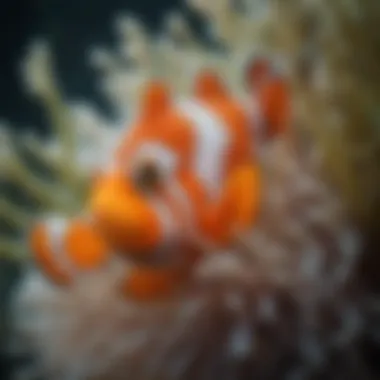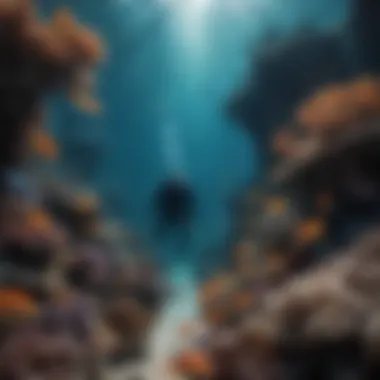Exploring the Rich Diversity of Fish in the Great Barrier Reef


Intro
The Great Barrier Reef stands as a vibrant testament to nature's grandeur, embodying one of the most complex marine ecosystems on Earth. With over 1,500 species of fish recorded, this UNESCO World Heritage site reveals astonishing diversity amid its coral expanses. The myriad of fish not only captures the imaginations of tourists and researchers alike, but each species plays a vital role in sustaining the ecological health of the reef. Additionally, understanding the delicate balance of life in this ecosystem can shine a light on the challenges facing marine environments worldwide.
Data indicates that many species contribute to the reef's structural integrity, feeding patterns, and overall biodiversity. From the brightly colored clownfish darting through anemones to the imposing blacktip reef shark patrolling the deeper waters, each creature has evolved distinctly to thrive in its unique habitat. However, factors such as climate change, pollution, and overfishing jeopardize these delicate species.
As we venture into the depths of research and conversation on fish diversity within the Great Barrier Reef, it’s essential to look at the methodologies employed to study these creatures and draw conclusions on their ecological roles. The significance of this knowledge extends beyond mere fascination; it informs conservation efforts crucial for preserving this natural wonder for future generations.
Foreword to the Great Barrier Reef
The Great Barrier Reef isn't just a stretch of water filled with fish; it’s a thriving ecosystem that draws attention both locally and globally. Spanning over 344,000 square kilometers off the coast of Queensland, Australia, it's the largest coral reef system in the world. When one thinks of this iconic reef, images of vibrant corals and the bustling marine life often come to mind. However, understanding the diversity of fish species here is crucial for grasping the overall health and resilience of the entire ecosystem.
The significance of the Great Barrier Reef stretches far beyond just its aesthetic appeal. It plays a pivotal role in local economies through fishing and tourism, and it serves as a living laboratory for scientists and researchers studying marine biology and conservation. Fish species in this habitat contribute to the ecological balance, each playing its own part in the food web and influencing the health of coral and other marine organisms. Its diversity includes both well-known species, such as the clownfish, and those that are less recognized, yet equally vital.
In dissecting the myriad fish species that inhabit the reef, one uncovers layers of complexity and interdependence. Each species, from the robust groupers to the delicate damselfish, brings something unique to the table. This exploration will dive into the estimated number of fish species, the endemic and migratory species, and their ecological roles, all crucial elements in maintaining the reef’s delicate harmony.
Geographical Overview
The Great Barrier Reef stretches along the northeastern coast of Australia, encompassing an array of islands and cays. From the tropical waters of the northern regions to the temperate conditions of the southern parts, the geographical diversity plays a significant role in shaping the fish populations found here. The presence of lagoons, coral atolls, and deeper oceanic waters creates various niches that different species have adapted to over thousands of years.
Geographically, the reef is divided into segments, each with distinct features that support unique communities of fish. These segments are influenced by environmental factors like water temperature, sunlight penetration, and nutrient availability, which can vary greatly across short distances. The Great Barrier Reef is often viewed as a biological treasure chest, where the amalgamation of various habitats nurtures a staggering variety of life forms.
Significance of the Reef
The ecological significance of the Great Barrier Reef transcends merely being a tourist attraction; it serves as a crucial habitat that supports a diverse array of fish species which, in turn, contributes to the global biodiversity. The reef functions as a breeding ground for numerous marine species, including many that are commercially valuable. This biological richness has far-reaching implications for fisheries both locally and globally.
Moreover, the reef’s health can serve as an indicator of broader environmental conditions. Many scientists view the shifts in fish populations as reflective of the broader impacts of climate change and human activities, such as pollution and overfishing. The implications of these changes, particularly in regard to fish species diversity, cannot be overstated.
"The integrity of the Great Barrier Reef is not just an issue for Australia; it is a global concern, as it supports marine biodiversity that many nations rely on for food, economy, and ecological balance."
Recognizing the vital importance of the Great Barrier Reef is essential for appreciating the necessity of ongoing conservation efforts. Each fish species within these waters tells a story of adaptation and survival, which underscores the importance of understanding and preserving such a remarkable ecosystem.
Fish Species Diversity
Estimated Number of Fish Species
The Great Barrier Reef is home to an estimated 1,500 species of fish. This remarkable number makes it one of the most diverse marine ecosystems in the world. The variety ranges from small reef fish like gobies to large pelagic species, such as marlins and tunas. The sheer abundance of habitats within the reef, including lagoons, coral gardens, and rocky outcrops, provides niches for the vast number of species to thrive. This diversity is crucial for ecological stability; it allows for various roles to be fulfilled, ensuring the overall health of the reef.
Interestingly, new species continue to be discovered, signaling that even in well-studied areas, the mysteries of marine life remain far from fully unraveled. Through ongoing marine research, scientists have identified new fish species that previously went unnoticed in the colorful tapestry of the reef.
Endemic Species
Among the many fish that inhabit the Great Barrier Reef, there are several endemic species, which means they are found nowhere else on Earth. These species, such as the Amporichthys johnsoni or the Pseudochromis kretzschmari, have adapted uniquely to the specific conditions of the reef. The presence of endemic species highlights the ecological significance of the reef's environment. It underscores the need for conservation efforts, as these species are particularly vulnerable to changes caused by climate shifts, pollution, and habitat destruction.
Moreover, endemic species often play specialized roles within their ecosystems. For instance, some might be involved in niche feeding behaviors that other, more widely distributed species are not. Understanding these unique species provides insight into the functioning and health of the reef itself.
Migratory Species
In addition to its resident fish populations, the Great Barrier Reef also serves as a crucial stopover for migratory fish species. From majestic manta rays to schools of trevally, the reef supports various migratory routes that are important for breeding, feeding, and growth. Many of these species travel vast distances, using the reef's rich resources along the way.


Migratory species like the barramundi can traverse hundreds of kilometers, showcasing the interconnected nature of marine ecosystems.
This migratory behavior contributes to the genetic diversity of fish populations and enhances the resilience of marine life in the face of environmental changes. Keeping migratory pathways open and protected is vital for maintaining these dynamic interactions.
Ecological Roles of Fish Species
Primary Consumers
In the bustling tapestry of life beneath the waves, primary consumers form a fundamental layer of the food web. Herbivorous fish such as parrotfish and surgeonfish are not merely munching on algae; their grazing activities help maintain the health of coral reefs by preventing algae overgrowth. When these fish graze on algae, they create space for coral growth and promote biodiversity by allowing smaller organisms to thrive.
In addition to habitat maintenance, these fish also contribute organic matter back into the ecosystem when they defecate, aiding nutrient cycling. It’s a classic case of the saying, "one man's trash is another man's treasure,” highlighting how the byproducts of one species nourish others in the ecosystem.
Predators and Their Impact
Evolutionary dynamics hold no punches in the Great Barrier Reef, where predators like the great barracuda and blacktip reef sharks maintain the balance between species. The interactive dance between predators and their prey dictates the population dynamics across species. By controlling the number of herbivores and smaller fish, these top predators play an essential role in preventing overgrazing on corals and algae.
Interestingly, studies show that a decline in predator fish can lead to an explosion of herbivorous fish populations, leading to drastic changes in the reef's structure. This can create a scenario known as a trophic cascade, where the removal of key predatory fish disrupts the balance, eventually leading to coral degradation. The health of these top predators is a telling sign of the reef's overall wellbeing – they are the litmus test for the ecosystem.
Habitat Modifiers
Fish species are also remarkable architects of their environments. The behavior of species like the damselfish, which aggressively defend their algal gardens, reveals how fish can influence habitat structure. They clear an area of competing species and encourage the growth of certain algae, which not only provides food resources but also offers shelter for juvenile fish and other organisms.
Moreover, schools of fish can also contribute to sediment dynamics by stirring up the ocean floor as they swim, influencing the distribution of nutrients and sediments. This interaction showcases how fish are true ecosystem engineers, shaping their surroundings in ways that may at first appear subtle but are profoundly influential.
"Understanding the roles of different fish species highlights the delicate balancing act that is necessary for a thriving ecosystem; it’s a reminder that every piece plays a part."
Research on Fish Species in the Reef
Research on fish species within the Great Barrier Reef is a critical endeavor that sheds light on the ecological dynamics of this complex marine ecosystem. It helps scientists and conservationists gain a comprehensive understanding of the relationships between fish species and their environment, enabling better management and protection of marine resources. Various studies, spanning decades, contribute to our knowledge about the diversity, population trends, and behavior of fish on the reef. The benefits of such research are manifold, ranging from informing conservation policies to enhancing public awareness about marine biodiversity. Unpacking the historical context, recent discoveries, and ongoing research initiatives will reveal the significance of these efforts.
Historical Studies
Historical studies on fish species in the Great Barrier Reef laid the essential groundwork for current marine biology. Initiated well before the advent of modern techniques, these studies utilized observational surveys and basic sampling methods to document fish diversity. For instance, early researchers like John Gilbert and later, Georgina Reid, captured their findings in the mid-20th century, compiling lists of species and providing insight into their habitats and behaviors.
These foundational efforts illustrated the astonishing number of fish species and their roles in maintaining ecological balance. They also set the stage for longitudinal studies, crucial for tracking changes over time due to natural and anthropogenic influences. The historical perspective is pivotal as it allows current researchers to recognize trends and variations in fish populations, which are essential for understanding how fish respond to environmental shifts.
Recent Findings
In recent years, advances in technology and methodologies have led to breakthroughs in understanding the Great Barrier Reef's fish species. Studies employing underwater survey techniques and genetic analysis have indicated that over 1,500 species of fish inhabit the reef. Notably, findings show that climate change and other stressors are threatening the livelihood of some species, presenting surprising changes in distribution patterns.
Research has also highlighted the resilience of certain species, like the clownfish, which exhibit unique adaptability to their sea anemone hosts even in disrupted environments. Additionally, it was found that some species traditionally thought to be significant to reef health are actually more vulnerable to environmental stresses than previously assumed. Such insights underscore the delicate balance of the ecosystem and the urgent need for conservation strategies geared towards protecting critical habitats and the species that rely on them.
Ongoing Research Projects
Currently, numerous ongoing research projects focus on understanding the ramifications of biodiversity loss in the reef. Institutions like the Australian Institute of Marine Science are at the forefront of these efforts, leading initiatives aimed at monitoring fish populations and habitat conditions across various reef systems.
Some key aspects of these ongoing projects include:
- Habitat restoration: Efforts to restore damaged reef areas and assess the effectiveness of different restoration techniques.
- Climate impact studies: Investigating how rising sea temperatures and ocean acidification are affecting fish behavior and physiology.
- Citizen science programs: Involving local communities in data collection, creating awareness, and fostering stewardship of the reef.
These projects not only deepen scientific knowledge but also promote community engagement and sustainable practices, making a crucial contribution to the long-term health of the Great Barrier Reef.


"Understanding the complexities of fish species diversity in the Great Barrier Reef is not just an academic pursuit; it's essential for the future of marine ecosystems globally."
Threats to Fish Species
The fish species that thrive in the Great Barrier Reef face a multitude of threats that jeopardize not only their survival but also the entire ecosystem’s balance. Understanding these threats is crucial to fostering awareness and promoting effective conservation measures. The reef is a complex web of life, and the health of its fish populations is directly reflective of the environmental conditions and human impacts upon it. Recognizing the elements that threaten these species can help in the formulation of strategies to safeguard their future.
Climate Change
Among the most pressing threats to fish species in the Great Barrier Reef is climate change. Rising ocean temperatures have far-reaching effects on marine life. Warmer waters lead to coral bleaching, a phenomenon where corals expel the algae living in their tissues, resulting in a loss of food sources for many fish species. This, in turn, disrupts the entire food web.
- Impact on Habitats: Fish such as the clownfish, which depend on specific types of coral for shelter, face diminishing habitats. As corals die off, fewer species can find refuge, leading to declines in their populations.
- Disruption of Breeding: Temperature increases can also affect the timing and success of breeding cycles. Fish have specific temperature ranges where breeding is optimal. Deviations can lead to reduced reproduction rates and increased mortality among larvae, ultimately threatening species’ future viability.
"The health of our oceans is inextricably linked to the well-being of fish species. If we ignore climate change, we may be signing a death warrant for many aquatic beings.”
Overfishing
Overfishing is another stark reality impacting the reef’s fish populations. With advancing technology, fishers can catch large quantities of fish with ease, often outpacing the natural replenishment rates.
- Targeted Species: Species such as the parrotfish and groupers are particularly at risk. These fish play critical roles in maintaining reef health by grazing on algae and helping to promote coral growth. Overexploitation could tilt the delicate balance of life in the ecosystem.
- Bycatch: The practice of catching unwanted fish species inadvertently also poses a severe risk. Juvenile fish and other non-target species often become collateral damage in the nets and traps, leading to population declines across various groups.
Pollution
Pollution is yet another significant threat contributing to the decline of fish species in the Great Barrier Reef. From plastic waste to chemical runoff, the impacts are grievous and far-reaching.
- Chemical Contaminants: Fertilizers and pesticides that wash into the ocean can cause algal blooms, which reduce oxygen levels in the water, harming fish populations. Toxic substances can accumulate in fish tissues, making them unhealthy for consumption by predators, including humans.
- Microplastics: The presence of microplastics in the water is also now a major concern. Many fish mistake these tiny particles for food, leading to ingestion that can result in malnutrition or internal injuries, drastically affecting fish health and growth rates.
Conservation Efforts
Conservation efforts are crucial for sustaining the diverse fish species found in the Great Barrier Reef. This massive ecosystem, rich in biodiversity, serves as a critical habitat not only for countless fish but also for other marine life. Understanding the significance of conservation strategies helps us appreciate the intricate relationships within this environment and the collective actions necessary to preserve it.
Protected Areas
Protected areas form the backbone of many conservation initiatives aimed at safeguarding fish species. These zones restrict certain human activities that can adversely affect marine life, such as fishing or coastal development. By designating parts of the reef as marine parks, the goal becomes clearer: to allow ecosystems to recover and thrive with minimal interference.
The Great Barrier Reef Marine Park is a prime example, where regulations are enforced to maintain biodiversity. This park is divided into zones, each serving a specific purpose. For instance, some zones are designated for fishing, while others are strictly no-take areas where fishing is prohibited. Such measures ensure that fish populations can rebound, helping to stabilize the overall health of the reef.
- Ecosystem Restoration: A well-managed protected area allows for the regeneration of fish stocks, which in turn supports predators and other species dependent on a balanced ecosystem.
- Research Opportunities: Protected zones provide scientists with natural labs where they can study marine life with less human impact, leading to discoveries that can enhance conservation techniques.
"Conservation isn't just about preventing loss; it’s about nurturing the systems that sustain life in the ocean."
Community Engagement
Involving local communities in conservation efforts is vital. Engaged communities often have the most intimate knowledge of the ecosystems they inhabit and can be powerful allies in conservation efforts. When residents understand the importance of the reef, they are more likely to protect it.
Community-led initiatives can include education programs, workshops, or hands-on participation in monitoring fish populations and habitats. For example, local fishermen may collaborate with researchers to report changes in fish behavior or population dynamics. Their first-hand observations form an invaluable database that can guide conservation actions.
- Sustainable Practices: Empowering local communities to adopt sustainable fishing techniques can drastically reduce the pressure on fish stocks.
- Cultural Preservation: Many communities have deep-rooted cultural connections to the reef. Engaging them in conservation efforts can also help sustain traditional practices that benefit the ecosystem.
Government Policies


Robust government policies play an essential role in the success of conservation initiatives for fish species. Legislation that protects marine habitats and imposes restrictions on harmful practices is critical. For instance, laws regulating pollution and coastal development directly impact the health of the reef and its fish population.
Moreover, governments are increasingly using research outcomes to inform policy decisions. For instance, guidelines for fishing quotas can be adjusted based on population studies, allowing fish stocks to recover while supporting the fishing industry.
- Funding and Resources: Government-led initiatives can also support restoration projects and the establishment of protected areas.
- International Collaboration: Since many fish species migrate, international cooperation is necessary to implement policies that extend beyond national boundaries.
Conservation efforts in the Great Barrier Reef are not just beneficial; they're essential. By combining protected areas, community involvement, and effective governance, we can cultivate a healthy ecosystem for future generations.
Future of Fish Species in the Great Barrier Reef
The future of fish species in the Great Barrier Reef is a topic that requires careful consideration. As climate changes and human activities continue to exert pressure on this delicate ecosystem, understanding the trajectory of these fish populations becomes essential for both ecological balance and the broader health of marine biodiversity. Fish species not only contribute to the ecological stability of the reef but also support local economies and cultures. Hence, any alteration in their future could have far-reaching implications. It’s crucial to address factors such as environmental changes, anthropogenic activities, and conservation strategies as we delve into the dynamics unfolding within this vital habitat.
Predictions and Models
Predictions regarding the future of fish species in the Great Barrier Reef largely hinge on various models that take into account environmental conditions, potential human impacts, and species adaptability. Many researchers have begun developing complex models that integrate these variables, allowing for potential outcomes to be anticipated.
For instance, models might illustrate how rising sea temperatures can alter fish breeding patterns and distributions. Coral species, synonymous with the reef, are inextricably linked to the fate of fish varieties. Studies indicate that certain fish species may migrate to cooler waters, thereby affecting local biodiversity and food webs.
Some key predictions drawn from existing research include:
- Shifts in fish distribution due to temperature changes may lead to invasive species entering the ecosystem.
- Decline in fish populations that are highly sensitive to temperature and habitat loss.
- Potential extinction of certain endemic fish species unable to adapt quickly enough to the changing conditions.
The capacity of fish species to adapt to these changes varies. Consequently, predictions must account for evolutionary responses alongside physical changes in habitats.
Role of Innovation in Conservation
Innovation plays a pivotal role in shaping the future of fish species within the Great Barrier Reef. As threats loom large, leveraging technology and new methods for monitoring and conservation is vital. Innovations such as satellite imagery and drone technology are beginning to reshape how researchers observe the reef.
These advancements provide clearer insights into fish populations and their habitats. Additionally, innovative breeding techniques are being developed to bolster the viability of overfished species.
Several noteworthy innovations include:
- Environmental DNA (eDNA) analysis: This technique enables scientists to detect fish species through genetic material found in water samples, streamlining surveys and monitoring.
- Artificial Intelligence (AI) in data analysis: AI systems can predict population trends and the impacts of environmental changes on fish species.
- Aquaculture advancements: Sustainable fish farming practices are being explored to reduce pressure on wild fish populations, ensuring species survival while meeting human demand.
These progressive steps signify a move toward preserving the rich biodiversity of the reef for future generations. Integrating innovation into conservation strategies not only aids in tackling current issues but also enhances our ability to predict and prepare for the unforeseen challenges that lie ahead.
The health of the Great Barrier Reef is a reflection of our choices. Understanding the complexities involved is fundamental to its conservation.
The End
The discussion revolving around fish species in the Great Barrier Reef is not just an academic exercise; it is crucial for understanding the broader implications of marine biodiversity and the vitality of our natural ecosystems. As we conclude this exploration, it becomes clear that the diversity found within this underwater wonderland is far more than a collection of colorful fish. It embodies complex ecological interactions, serves vital roles in maintaining the balance of marine habitats, and confronts escalating threats due to human impact and climate change.
Summary of Key Points
Throughout this article, we have highlighted several essential aspects:
- Diversity of Species: The Great Barrier Reef is home to over 1,500 fish species, each contributing unique attributes to the ecosystem.
- Ecological Connections: From primary consumers to apex predators, fish species play pivotal roles that sustain the health of the reef.
- Ongoing Threats: The multifaceted threats of climate change, overfishing, and pollution pose serious risks to the survival of these fish populations.
- Conservation Efforts: Various initiatives, including the establishment of protected areas and community engagement, aim to mitigate these threats and safeguard the biodiversity of the reef.
By grasping the intricacies of these points, stakeholders can appreciate the high stakes involved in preserving this natural treasure.
Call to Action
It is imperative that we act decisively. Efforts to protect the Great Barrier Reef must be ramped up, engaging both local communities and global citizens. Everyone plays a role in conservation; whether through responsible tourism practices, advocating for sustainable fishing policies, or participating in local clean-up efforts, our collective actions can lead to meaningful change.
"The health of our oceans reflects the health of our planet. Protecting fish species is not optional—it is essential for our future."
We encourage readers to stay informed and engaged with conservation efforts. Resources such as Wikipedia, Britannica, and community forums on Reddit can offer additional insights and pathways to involvement. By fostering a sense of stewardship and responsibility towards the Great Barrier Reef, we can ensure that its incredible diversity of fish species endures for generations to come.



